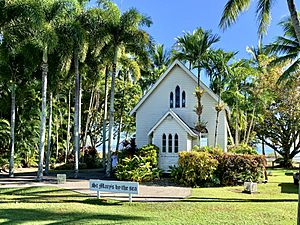St Mary's by the Sea, Port Douglas facts for kids
Quick facts for kids St Mary's by the Sea |
|
|---|---|

St Mary's by the Sea, 2020
|
|
| 16°28′46″S 145°27′44″E / 16.4795°S 145.4621°E | |
| Country | Australia |
| Denomination | Non-denominational (since 1988) |
| Previous denomination | Roman Catholic (1914–1988) |
| History | |
| Former name(s) | St Mary's Roman Catholic Church |
| Status | Church |
| Architecture | |
| Architectural type | Church |
| Style | Gothic Revival |
| Years built | 1913–1914 |
St Mary's by the Sea is a special church located in Port Douglas, Queensland, Australia. It's known as a "heritage-listed" building, which means it's important to history and protected. This church was built between 1913 and 1914. It used to be a Roman Catholic church but is now used by all Christian groups. It was officially added to the Queensland Heritage Register on October 21, 1992.
Contents
The History of St Mary's by the Sea
Building the Church
St Mary's by the Sea was built in 1914. It replaced an older Roman Catholic church in Port Douglas. That first church was destroyed by a powerful cyclone in March 1911.
Port Douglas started in 1877 as a port. It helped transport goods from the Hodgkinson goldfield. It also served as a center for nearby farms.
Early Church Life in Port Douglas
The Roman Catholic Church started working in North Queensland in 1877. They wanted to help Aboriginal people. But many European settlers, including Irish Catholics, also needed churches.
The first small chapel in Port Douglas opened in 1878. By November 1881, a church was built on Port Hill. This church was led by Father Pierre-Marie Bucas.
Challenges and Changes for Port Douglas
Port Douglas grew quickly at first. It was even bigger than Cairns, a nearby town. However, in 1885, Cairns was chosen for a new railway line. This made Cairns grow much faster.
After the railway opened in 1893, trade in Port Douglas slowed down. It almost stopped completely by 1908. Then, a very strong cyclone hit on March 16, 1911. It destroyed much of the town. The church and the priest's house were "blown to bits." The priest's house was rebuilt first. Church services were held there until the new church was finished in 1914.
Port Douglas Recovers and Changes
Port Douglas recovered from the cyclone. It became a sugar port from the 1890s until 1958. The town was also the main center for the Douglas Shire. But in the 1920s, the main offices moved to Mossman.
By the 1960s and 1970s, Port Douglas was a fishing and holiday town. It kept its old-fashioned charm. In the 1980s, it became a popular tourist spot. The old St Mary's Church was in poor condition. It was also too small for the growing community.
A New Home for the Church
In 1987, the Catholic Church gave the building to the local community. They asked that it still be used for Christian purposes. As a special project for Australia's 200th birthday (Bicentennial Project), the church was moved. It was relocated to parkland by the sea in November 1988.
The old land on Port Hill was sold to help build a new church elsewhere. After moving, the former St Mary's Church was repaired. It was renamed St Mary's by the Sea. Today, it is a community church for everyone. It hosts weddings, carol services, and other special events.
What St Mary's by the Sea Looks Like
St Mary's by the Sea is a small church. It is built in a style called "Gothic." It sits right by the water on Wharf Street.
The church is made of timber (wood). You can see the wooden frame on the outside. It stands on low wooden stumps. The roof is very steep and covered with corrugated iron. The building is shaped like a rectangle. It has a small room (vestry) at the back corner. There is also a small porch at the front. This porch has a gabled roof and windows. The side walls have simple wooden supports called buttresses.
Inside, you can see the roof structure. Three archways made of timber separate the main seating area (nave) from the front part (sanctuary).
Why St Mary's by the Sea is Important
St Mary's by the Sea was added to the Queensland Heritage Register on October 21, 1992. This means it is recognized as a very important historical place.
Showing Queensland's History
This church was built in 1914. It shows how Port Douglas grew in its early days. It also shows how the Catholic Church developed in North Queensland. It is one of the oldest buildings in Port Douglas. It helps us remember what the town looked like before it became a big tourist spot.
A Special Type of Building
St Mary's is a great example of a simple church. It was built for a small community in a faraway area. Its simple design shows how small towns dealt with cyclones. They often reused materials from damaged buildings.
Important to the Community
St Mary's has a strong connection to the Catholic community. It served the people of Port Douglas for many years. In 1988, the local community worked together to save and move the church. This shows how much they cared about it. Now, it is a special community building for everyone.


